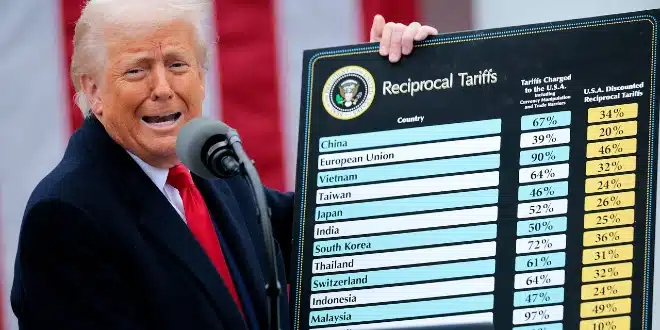After months of subdued readings, U.S. inflation picked up speed in June, reaching its highest level since February. The latest Consumer Price Index (CPI) report from the Bureau of Labor Statistics indicates that tariffs and supply chain costs are beginning to ripple more broadly through the economy.
Inflation Ticks Up on Higher Fuel and Import Costs
Consumer prices increased by 0.3% in June, lifting the annual inflation rate to 2.7%. This marks a notable jump from the 2.6% annual rate recorded in May and aligns closely with economists’ forecasts, which anticipated a rise fueled in part by climbing gas prices and expanding import costs.
Analysts had projected that rising energy prices would nudge the headline CPI upward, while also expecting more companies to begin transferring elevated import costs — many of them tied to new tariffs — to consumers. Both predictions played out as expected in the June report.
“This is the beginning of the tariff effect showing up in the numbers,” said Heather Long, chief economist at Navy Federal Credit Union. “It wasn’t a sharp shock, but it’s definitely visible.”
Core CPI, which excludes food and energy due to their price volatility, grew by 0.2% from the previous month and reached 2.9% on an annual basis. While slightly below forecasts, this still reflects a modest uptick from May’s 0.1% monthly and 2.8% yearly changes.
Market Reaction: Mixed Signals on Wall Street
Financial markets responded cautiously to the latest inflation data. The Dow Jones Industrial Average slipped by 250 points, or 0.5%, in early trading. Meanwhile, the broader S&P 500 held relatively steady, and the tech-heavy Nasdaq gained 0.65%.
Although the numbers didn’t exceed expectations, investors remained wary. “It’s reassuring that the June CPI didn’t overshoot, but it’s still clear that inflationary pressure has intensified compared to May,” noted Skyler Weinand, Chief Investment Officer at Regan Capital.
Tariff Policy Creates Economic Uncertainty
Much of the recent inflationary pressure stems from ongoing shifts in trade policy. The Trump administration has introduced extensive tariffs on a wide range of imported goods, disrupting pricing structures across industries.
The implementation has been inconsistent, contributing to uncertainty among both businesses and consumers. Some sectors have responded by accelerating purchases ahead of tariff deadlines, while others have attempted to absorb the cost increases — at least temporarily.
Until recently, overall inflation remained relatively restrained. Factors such as disinflation in housing, weaker travel demand, and preemptive inventory stockpiling helped dampen short-term pricing effects. But economists warned that this window was closing.
“Retailers were carrying extra inventory — about three months’ worth — ahead of the April tariff expansions,” Long explained. “That buffer is thinning out now, so we’re beginning to see the costs of tariffs filter into consumer prices.”
She emphasized that this is likely the first stage of a broader trend. “This is just inning one. More price increases are on the way as inventories run low and restocking comes at a higher cost.”
Which Goods Are Seeing the Steepest Price Increases?
While overall inflation remains moderate, several categories of consumer goods — particularly those heavily dependent on imports — are starting to see sharp price hikes.
1. Commodities excluding food and energy: This category, watched closely for tariff impact, rose 0.2% in June after remaining unchanged in May.
2. Tech devices and accessories: For the third month in a row, prices for computers, peripherals, and smart home devices rose — up 1.4% in June. Although the administration granted partial exemptions for some electronics, many items still face the base tariff rate, especially components like semiconductors.
3. Household textiles: The price of items such as window treatments, rugs, and linens surged 4.2% — the largest monthly jump since tracking began in 1999. U.S. reliance on imported textiles is a major factor.
4. Appliances: A category already hit by metals tariffs saw prices rise 1.9% in June, marking the steepest climb since August 2020. The recent extension of tariffs on steel and aluminum derivatives, including dryers, ovens, and washing machines, contributed to the increase.
5. Tools and hardware: Once experiencing price declines, this segment posted its fifth consecutive monthly increase, up 0.7% in June.
6. Sporting goods: Prices accelerated here too, rising 1.4% in June — the highest pace in a year and a half.
7. Toys: Toy prices rose 1.4% for the second straight month. With roughly 80% of U.S. toys sourced from China, tariff exposure in this sector is especially high.
8. Video equipment: In a rare shift for this historically deflationary category, prices jumped 4.5% in June — a record monthly increase.
What Comes Next?
With tariffs continuing to work their way through supply chains and businesses reaching the end of their pre-tariff inventory buffers, inflationary momentum may persist into the second half of the year. Economists expect more consumer goods — especially those with deep import ties — to reflect these pressures in the months ahead.
While inflation has not yet spiraled out of control, the current trajectory suggests the potential for a broader impact. As the effects of trade policy ripple outward, both consumers and markets will be watching closely.


